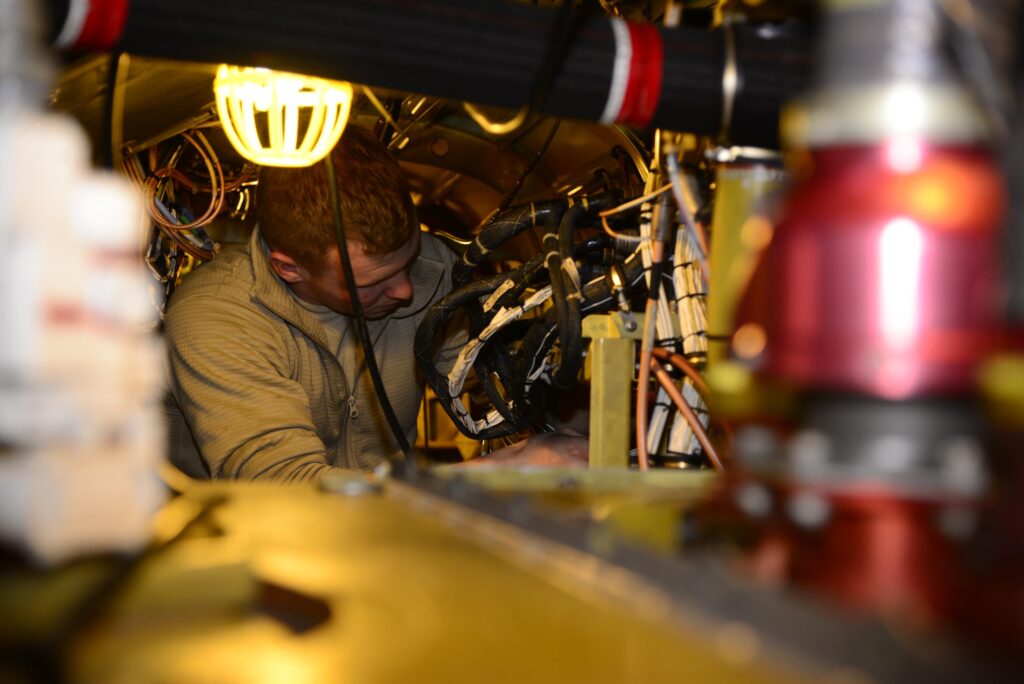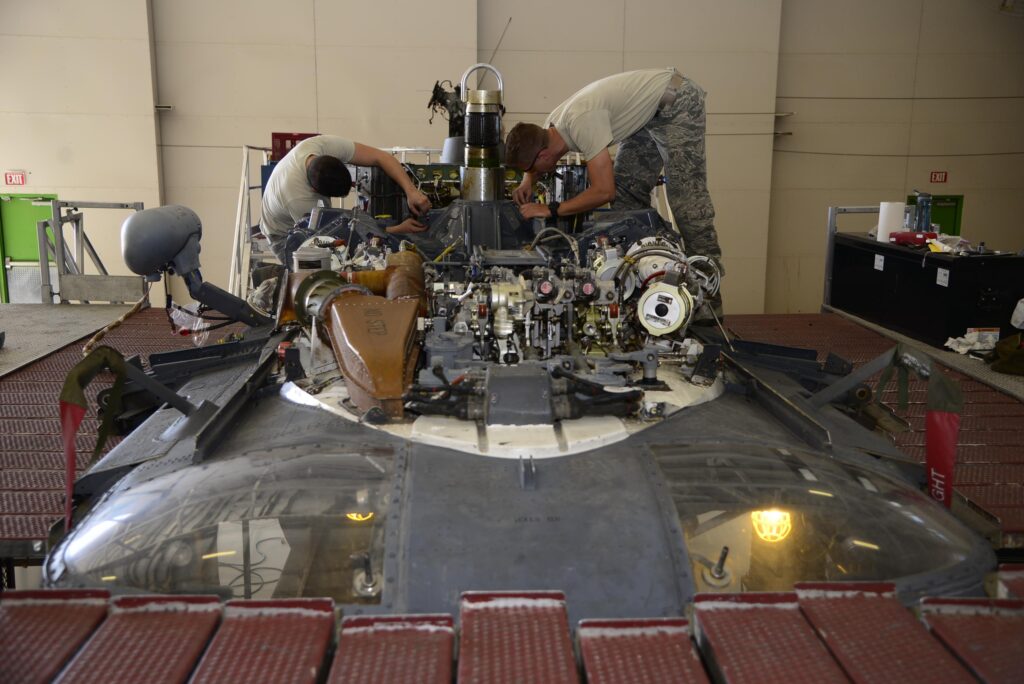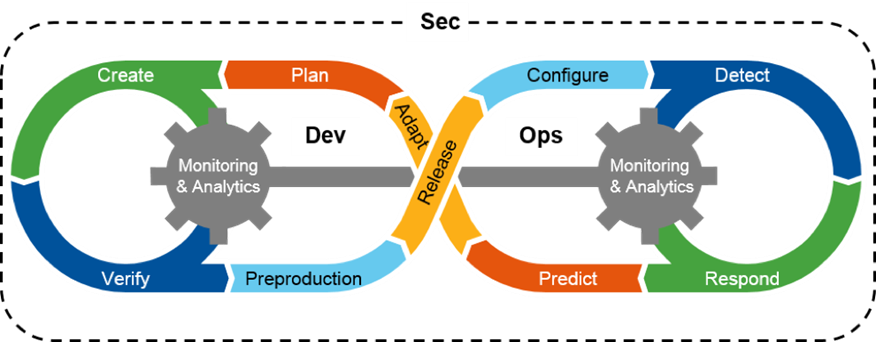
An Air Force maintenance sergeant at work on an HH-60 helicopter.
WASHINGTON: “When you talk about defense spending, there are very few places that you can spend money and actually get a positive fiscal return on your investment,” notes Lt. Gen. Mike Groen, director of the Pentagon’s Joint Artificial Intelligence Center. “AI has places where you can actually spend money to make money.”

Lt. Gen. Michael Groen
[Click here for Part I of our exclusive interview with Lt. Gen Groen]
But before any given organization in the Defense Department can reap the benefits of AI, Groen told me in an exclusive interview, it has to do two things:
First, would-be adopters of AI can’t rely on Groen’s JAIC to do all the heavy lifting. They have to be active participants. To do AI right, you have to invest your own time, effort, and, yes, money up front, especially to make sense of what data you have and what data you need.
“The kind of problem that will get solved is a problem that’s bad enough that the agency or entity that has that problem is willing to invest some money in getting it fixed,” Groen told me.
Second, would-be adopters of AI can’t rely on traditional, cumbersome Pentagon processes for procurement and management.
“We still have a base process that we’ve inherited from the 1960s in the Department [of Defense],” Groen said. “In some cases, it works well. But in other cases, it’s no longer a good fit for a data-driven information age.” In particular, he said, “this requires the department to become much more adept at software engineering, and we don’t do that well yet today.”
Groen’s confident that JAIC and its partner organizations on multiple pilot projects – from Special Operations Command to the Defense Health Agency – are overcoming those obstacles.
“There’s all sorts of these low-hanging-fruit, enterprise efficiency and enterprise effectiveness use-cases that we’re excited to get after,” he told me.

UH-60 Black Hawks
Saving Money, SOCOM Style
One of the Joint AI Center’s most successful pilot projects is a joint effort with the 160th Special Operations Air Regiment (who fly special operators into scary places) to apply AI to streamline of one of Special Operations Command’s most expensive activities: maintaining its fleet of helicopters, many of them specially modified for special ops.
“We just recently finished a couple of different preventive helicopter maintenance AIs,” Groen told me. One squadron of H-60 helicopters, for example, had issued its maintenance techs with tablets to record the conditions of the aircraft and the work done on them in digital form – making it easy for an AI to digest and analyze.
“They have a digital tablet that that squadron uses to just capture all of their maintenance data,” Groen said. “Based on all of the historic data that they had collected, we created a model that allowed them, pre-flight, to be able to estimate if an engine was at risk of failure.”
In “at least one case,” Groen said, the unit pulled a helicopter out of the flight line because the AI predicted an engine failure, and when the maintainers opened it up, the AI was right: “It was actually, in fact, ready to fail.” That kind of “predictive maintenance” can forestall costly and potentially dangerous breakdowns in flight.
But the AI can also save money by telling you when you don’t have to perform a costly maintenance procedure. Today’s preventive maintenance manuals typically prescribe overhauling key components every certain number of flight-hours, based on traditional rules of thumb, much like changing your car’s oil every 3,000 miles. Sometimes this catches incipient problems, other times it’s premature.
“Taking an engine out of an aircraft, putting a new engine into the aircraft, taking that old engine, putting it into a container, shipping it across the country to a depot, having the depot open it, do a complete evaluation – only to find that that engine is perfectly fine, and there’s no failure… [that] costs millions of dollars when you look at the enterprise writ large,” Groen said.

Air Force techs doing a regularly scheduled maintenance inspection on an HH-60.
Once you work out AI-driven predictive maintenance with an individual squadron, he added, it’s not hard to scale it up to every squadron using that aircraft – or even for different types of aircraft, once you feed the proven algorithm the appropriate data for each new type.
“You can repurpose that model to another type-model series, let’s say the CV-22s or the MV-22 fleets,” he went on. “It’s not a matter of developing a new thing. It’s a matter of tweaking an algorithm, aligning your data, and then training that algorithm to that new type-model series.”
Indeed, as more and more defense department organizations embrace AI, the JAIC should be increasingly able to take algorithms created for one function and repurpose them for others. “We run into this all the time,” Groen said. “You can start to use the same algorithms, just populated and trained with new data. [For example,] ‘hey, wait a minute. Your use case looks just like this one that the Navy did last year. And so let’s take that Navy algorithm and repurpose it with your data.’”
So Groen sees the SOCOM preventive-maintenance pilot as just the leading edge for a much wider array of AI-driven efficiencies. Just consider the huge amounts of stuff the Defense Department has to buy, store and ship around the planet, from fuel to spare parts to smart bombs: There are plenty of lessons to be learned from private-sector early adopters of AI, like Amazon.
“Look at the logistics enterprise…. all the way from combat logistics practiced in a small unit, to theater logistics [with] large ships and airplanes and massive amounts of logistics moving around, all the way to the Defense Logistics Agency, for example, or United States Transportation Command,” Groen told me. “Hundreds of billions of dollars a year are spent…. That could show enormous returns in efficiency and effectiveness.”
AI can also automate audits, a chronically painful process in the Pentagon. “We have an AI that helps a user match unmatched financial transactions,” Groen said. “People could be much better used if they were freed from the drudgery of matching spreadsheets and actually spend that human capital, that talent, in doing budget planning and resource allocation.
“Similarly, in human capital management… admin sections across the department, hundreds of them, are still doing manual processes with manual record jackets,” he said. “You’ll go to the computer, and you’ll fill out a form – then you’ll print the form and put it in a folder. What information company operates like that?
“The defense health enterprise is another great one,” he went on. “We’ve got several defense health initiatives because the potential return on investment is so high.”
No, the Defense Health Agency doesn’t have the kind of in-house expertise on cutting-edge AI that, say, the Air Force does. But it has great data, Groen said – not only data in quantity, but data in formats that can be readily digested by AI algorithms without prohibitively labor-intensive clean-up and labeling.
What the Joint AI Center can provide is the technical expertise and software tools to implement private-sector best practices, like integrated software development, security, & operations, aka DevSecOps.

A diagram of the DevSecOps (Development – Security – Operations) model for developing software.
Getting The Process Right
Traditional Pentagon weapons programs spend years in R&D before they deliver a prototype you can actually test, let alone a product ready for operations in the field. But with software, you can quickly develop a Minimum Viable Product as a proof of concept, build in basic cybersecurity, and give it to real users to try out in real operations. Then those users give you feedback to develop the next version, which you build and give back to them for more feedback, and so in in a virtuous cycle of improvements.
“You build a little, you test a little, you try it out, you fix it, and then you add more,” Groen said. “That’s how we will grow.”
Getting this virtuous cycle going requires DevSecops expertise and software development tools that far from common across the Defense Department. That’s where the Joint AI Center and its cloud-based Joint Common Foundation come in.
For example, “the Defense Health Agency does not have a DevSecOps environment… Well, here’s an opportunity for us to work with them by giving them [one],” Groen said. “So now they can develop their own AIs, they can develop their own data, they can get their data labeled, and they can start testing and training algorithms.”
The Joint AI Center can also connect other Defense Department organizations to vetted, trustworthy contractors. “There’s a danger of organizations who just want to throw a contract out there… for AI,” Groen said. “They will find somebody who’s very willing to take their money and do that for them, but they don’t know how to evaluate.”
“They don’t have a good sense for, ‘Am I getting ripped off here? Am I protecting my intellectual property? Could we be doing this cheaper? Is there a better way?’ The JAIC can serve that function,” Groen said. “The JAIC has history with a whole plethora of contractors in the space. JAIC partners with DIU out in the Silicon Valley, where we have access to hundreds of vendors. So, when we help a customer … we can say, ‘There are a handful of vendors that are really good at exactly your problem.’”
But even with the right contractors, the right processes, the right algorithms, some AI projects will still fail, Groen warned. Others will have rough starts as they go through the initial DevSecOps cycles of build-test-improve.
“We need… the patient, strategic leadership to let things grow and fail, and take the winners and continue to move on,” Groen said. “Unfortunately, our processes, today, mitigate against that, because our processes are designed to kill the weak. And so, when our development programs stumble in today’s environment… all their money goes away, and it collapses.”
Pentagon managers can’t hit the panic button and bail out prematurely, he said. You have to give AI time – and accept some failures as inevitable when you experiment with new ways of doing things.
“We need this explosion of use cases and technologies, so that then we can start stitching them together into organized enterprise” across the Defense Department,” Groen told me. “It’s way too early to start culling the herd.”
Pentagon announces new reciprocity guidance to streamline software adaptation
“We’ve heard you loud and clear on this within the DoD. I’m not going to say this is going to solve every bit of it, but it’s going to help us a bit,” Pentagon CIO John Sherman said.



























